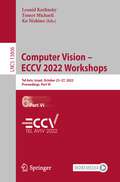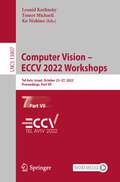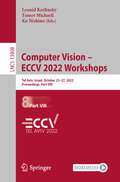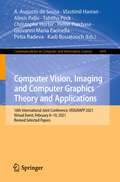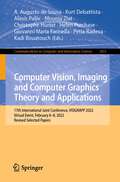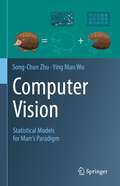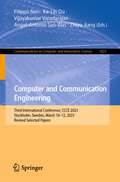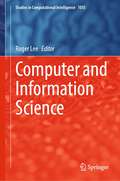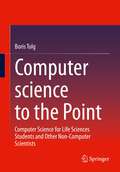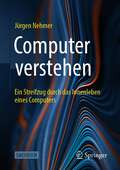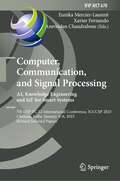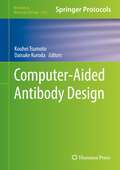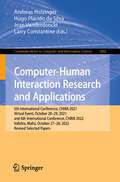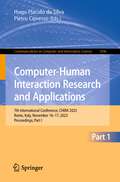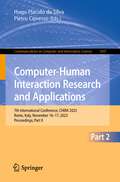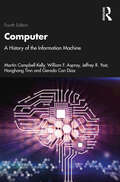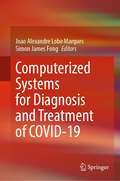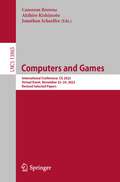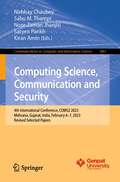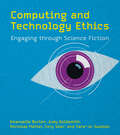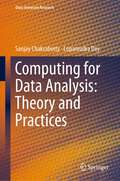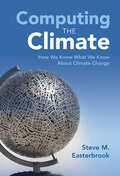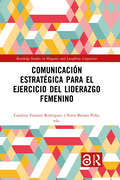- Table View
- List View
Computer Vision – ECCV 2022 Workshops: Tel Aviv, Israel, October 23–27, 2022, Proceedings, Part VI (Lecture Notes in Computer Science #13806)
by Ko Nishino Leonid Karlinsky Tomer MichaeliThe 8-volume set, comprising the LNCS books 13801 until 13809, constitutes the refereed proceedings of 38 out of the 60 workshops held at the 17th European Conference on Computer Vision, ECCV 2022. The conference took place in Tel Aviv, Israel, during October 23-27, 2022; the workshops were held hybrid or online.The 367 full papers included in this volume set were carefully reviewed and selected for inclusion in the ECCV 2022 workshop proceedings. They were organized in individual parts as follows: Part I: W01 - AI for Space; W02 - Vision for Art; W03 - Adversarial Robustness in the Real World; W04 - Autonomous Vehicle Vision Part II: W05 - Learning With Limited and Imperfect Data; W06 - Advances in Image Manipulation; Part III: W07 - Medical Computer Vision; W08 - Computer Vision for Metaverse; W09 - Self-Supervised Learning: What Is Next?; Part IV: W10 - Self-Supervised Learning for Next-Generation Industry-Level Autonomous Driving; W11 - ISIC Skin Image Analysis; W12 - Cross-Modal Human-Robot Interaction; W13 - Text in Everything; W14 - BioImage Computing; W15 - Visual Object-Oriented Learning Meets Interaction: Discovery, Representations, and Applications; W16 - AI for Creative Video Editing and Understanding; W17 - Visual Inductive Priors for Data-Efficient Deep Learning; W18 - Mobile Intelligent Photography and Imaging; Part V: W19 - People Analysis: From Face, Body and Fashion to 3D Virtual Avatars; W20 - Safe Artificial Intelligence for Automated Driving; W21 - Real-World Surveillance: Applications and Challenges; W22 - Affective Behavior Analysis In-the-Wild; Part VI: W23 - Visual Perception for Navigation in Human Environments: The JackRabbot Human Body Pose Dataset and Benchmark; W24 - Distributed Smart Cameras; W25 - Causality in Vision; W26 - In-Vehicle Sensing and Monitorization; W27 - Assistive Computer Vision and Robotics; W28 - Computational Aspects of Deep Learning; Part VII: W29 - Computer Vision for Civil and Infrastructure Engineering; W30 - AI-Enabled Medical Image Analysis: Digital Pathology and Radiology/COVID19; W31 - Compositional and Multimodal Perception; Part VIII: W32 - Uncertainty Quantification for Computer Vision; W33 - Recovering 6D Object Pose; W34 - Drawings and Abstract Imagery: Representation and Analysis; W35 - Sign Language Understanding; W36 - A Challenge for Out-of-Distribution Generalization in Computer Vision; W37 - Vision With Biased or Scarce Data; W38 - Visual Object Tracking Challenge.
Computer Vision – ECCV 2022 Workshops: Tel Aviv, Israel, October 23–27, 2022, Proceedings, Part VII (Lecture Notes in Computer Science #13807)
by Ko Nishino Leonid Karlinsky Tomer MichaeliThe 8-volume set, comprising the LNCS books 13801 until 13809, constitutes the refereed proceedings of 38 out of the 60 workshops held at the 17th European Conference on Computer Vision, ECCV 2022. The conference took place in Tel Aviv, Israel, during October 23-27, 2022; the workshops were held hybrid or online.The 367 full papers included in this volume set were carefully reviewed and selected for inclusion in the ECCV 2022 workshop proceedings. They were organized in individual parts as follows: Part I: W01 - AI for Space; W02 - Vision for Art; W03 - Adversarial Robustness in the Real World; W04 - Autonomous Vehicle Vision Part II: W05 - Learning With Limited and Imperfect Data; W06 - Advances in Image Manipulation; Part III: W07 - Medical Computer Vision; W08 - Computer Vision for Metaverse; W09 - Self-Supervised Learning: What Is Next?; Part IV: W10 - Self-Supervised Learning for Next-Generation Industry-Level Autonomous Driving; W11 - ISIC Skin Image Analysis; W12 - Cross-Modal Human-Robot Interaction; W13 - Text in Everything; W14 - BioImage Computing; W15 - Visual Object-Oriented Learning Meets Interaction: Discovery, Representations, and Applications; W16 - AI for Creative Video Editing and Understanding; W17 - Visual Inductive Priors for Data-Efficient Deep Learning; W18 - Mobile Intelligent Photography and Imaging; Part V: W19 - People Analysis: From Face, Body and Fashion to 3D Virtual Avatars; W20 - Safe Artificial Intelligence for Automated Driving; W21 - Real-World Surveillance: Applications and Challenges; W22 - Affective Behavior Analysis In-the-Wild; Part VI: W23 - Visual Perception for Navigation in Human Environments: The JackRabbot Human Body Pose Dataset and Benchmark; W24 - Distributed Smart Cameras; W25 - Causality in Vision; W26 - In-Vehicle Sensing and Monitorization; W27 - Assistive Computer Vision and Robotics; W28 - Computational Aspects of Deep Learning; Part VII: W29 - Computer Vision for Civil and Infrastructure Engineering; W30 - AI-Enabled Medical Image Analysis: Digital Pathology and Radiology/COVID19; W31 - Compositional and Multimodal Perception; Part VIII: W32 - Uncertainty Quantification for Computer Vision; W33 - Recovering 6D Object Pose; W34 - Drawings and Abstract Imagery: Representation and Analysis; W35 - Sign Language Understanding; W36 - A Challenge for Out-of-Distribution Generalization in Computer Vision; W37 - Vision With Biased or Scarce Data; W38 - Visual Object Tracking Challenge.
Computer Vision – ECCV 2022 Workshops: Tel Aviv, Israel, October 23–27, 2022, Proceedings, Part VIII (Lecture Notes in Computer Science #13808)
by Ko Nishino Leonid Karlinsky Tomer MichaeliThe 8-volume set, comprising the LNCS books 13801 until 13809, constitutes the refereed proceedings of 38 out of the 60 workshops held at the 17th European Conference on Computer Vision, ECCV 2022. The conference took place in Tel Aviv, Israel, during October 23-27, 2022; the workshops were held hybrid or online.The 367 full papers included in this volume set were carefully reviewed and selected for inclusion in the ECCV 2022 workshop proceedings. They were organized in individual parts as follows: Part I: W01 - AI for Space; W02 - Vision for Art; W03 - Adversarial Robustness in the Real World; W04 - Autonomous Vehicle Vision Part II: W05 - Learning With Limited and Imperfect Data; W06 - Advances in Image Manipulation; Part III: W07 - Medical Computer Vision; W08 - Computer Vision for Metaverse; W09 - Self-Supervised Learning: What Is Next?; Part IV: W10 - Self-Supervised Learning for Next-Generation Industry-Level Autonomous Driving; W11 - ISIC Skin Image Analysis; W12 - Cross-Modal Human-Robot Interaction; W13 - Text in Everything; W14 - BioImage Computing; W15 - Visual Object-Oriented Learning Meets Interaction: Discovery, Representations, and Applications; W16 - AI for Creative Video Editing and Understanding; W17 - Visual Inductive Priors for Data-Efficient Deep Learning; W18 - Mobile Intelligent Photography and Imaging; Part V: W19 - People Analysis: From Face, Body and Fashion to 3D Virtual Avatars; W20 - Safe Artificial Intelligence for Automated Driving; W21 - Real-World Surveillance: Applications and Challenges; W22 - Affective Behavior Analysis In-the-Wild; Part VI: W23 - Visual Perception for Navigation in Human Environments: The JackRabbot Human Body Pose Dataset and Benchmark; W24 - Distributed Smart Cameras; W25 - Causality in Vision; W26 - In-Vehicle Sensing and Monitorization; W27 - Assistive Computer Vision and Robotics; W28 - Computational Aspects of Deep Learning; Part VII: W29 - Computer Vision for Civil and Infrastructure Engineering; W30 - AI-Enabled Medical Image Analysis: Digital Pathology and Radiology/COVID19; W31 - Compositional and Multimodal Perception; Part VIII: W32 - Uncertainty Quantification for Computer Vision; W33 - Recovering 6D Object Pose; W34 - Drawings and Abstract Imagery: Representation and Analysis; W35 - Sign Language Understanding; W36 - A Challenge for Out-of-Distribution Generalization in Computer Vision; W37 - Vision With Biased or Scarce Data; W38 - Visual Object Tracking Challenge.
Computer Vision, Imaging and Computer Graphics Theory and Applications: 16th International Joint Conference, Visigrapp 2021, Vienna, Austria, February 8-10, 2021, Revised Selected Papers (Communications In Computer And Information Science Series #1691)
by Petia Radeva Giovanni Maria Farinella Helen Purchase Christophe Hurter Kadi Bouatouch Alexis Paljic A. Augusto de Sousa Vlastimil Havran Tabitha Peck<p>This book constitutes the refereed proceedings of the 16th International Joint Conference on Computer Vision, Imaging and Computer Graphics Theory and Applications, VISIGRAPP 2021, held as a virtual event, February 8–10, 2021.<p> <p>The 16 full papers presented in this volume were carefully reviewed and selected from 371 submissions. The purpose of VISIGRAPP is to bring together researchers and practitioners interested in both theoretical advances and applications of computer vision, computer graphics and information visualization. VISIGRAPP is composed of four co-located conferences, each specialized in at least one of the aforementioned main knowledge areas, namely GRAPP, IVAPP, HUCAPP and VISAPP.<p> <p>The contributions were organized in topical sections as follows: Computer Graphics Theory and Applications; Human Computer Interaction Theory and Applications; Information Visualization Theory and Applications; Computer Vision Theory and Applications.<p>
Computer Vision, Imaging and Computer Graphics Theory and Applications: 17th International Joint Conference, VISIGRAPP 2022, Virtual Event, February 6–8, 2022, Revised Selected Papers (Communications in Computer and Information Science #1815)
by Petia Radeva Giovanni Maria Farinella Helen Purchase Christophe Hurter Kurt Debattista Kadi Bouatouch Alexis Paljic A. Augusto de Sousa Mounia ZiatThis book constitutes the referred proceedings of the 17th International Joint Conference on Computer Vision, Imaging and Computer Graphics Theory and Applications, VISIGRAPP 2022, Virtual Event, February 6–8, 2022. The 15 full papers included in this book were carefully reviewed and selected from 392 submissions. The purpose of VISIGRAPP is to bring together researchers and practitioners interested in both theoretical advances and applications of computer vision, computer graphics and information visualization. VISIGRAPP is composed of four co-located conferences, each specialized in at least one of the aforementioned main knowledge areas, namely GRAPP, IVAPP, HUCAPP and VISAPP.
Computer Vision: Statistical Models for Marr's Paradigm
by Song-Chun Zhu Ying Nian WuAs the first book of a three-part series, this book is offered as a tribute to pioneers in vision, such as Béla Julesz, David Marr, King-Sun Fu, Ulf Grenander, and David Mumford. The authors hope to provide foundation and, perhaps more importantly, further inspiration for continued research in vision. This book covers David Marr's paradigm and various underlying statistical models for vision. The mathematical framework herein integrates three regimes of models (low-, mid-, and high-entropy regimes) and provides foundation for research in visual coding, recognition, and cognition. Concepts are first explained for understanding and then supported by findings in psychology and neuroscience, after which they are established by statistical models and associated learning and inference algorithms. A reader will gain a unified, cross-disciplinary view of research in vision and will accrue knowledge spanning from psychology to neuroscience to statistics.
Computer and Communication Engineering: Third International Conference, CCCE 2023, Stockholm, Sweden, March 10–12, 2023, Revised Selected Papers (Communications in Computer and Information Science #1823)
by Ke-Lin Du Vijayakumar Varadarajan Filippo Neri Zhiyu Jiang Angel-Antonio San-BlasThis book constitutes refereed proceedings of the Third International Conference on Computer and Communication Engineering, CCCE 2023, held in Stockholm, Sweden, in March 2023.The 18 full papers presented were carefully reviewed and selected from 36 submissions. The papers are organized in the following topical sections: image analysis and method; network model and function analysis of mobile network; system security estimation and analysis of data network; and AI-based system model and algorithm.
Computer and Information Science (Studies in Computational Intelligence #1055)
by Roger LeeThis book presents scientific results of the 22nd IEEE/ACIS International Conference on Computer and Information Science (ICIS 2022) held on June 26-28, 2022 in Zhuhai China. The aim of this conference was to bring together researchers and scientists, businessmen and entrepreneurs, teachers, engineers, computer users, and students to discuss the numerous fields of computer science and to share their experiences and exchange new ideas and information in a meaningful way. Research results about all aspects (theory, applications, and tools) of computer and information science and to discuss the practical challenges encountered along the way and the solutions adopted to solve them. The conference organizers selected the best papers from those papers accepted for presentation at the conference. The papers were chosen based on review scores submitted by members of the program committee and underwent further rigorous rounds of review. From this second round of review, 14 of the conference’s most promising papers are then published in this Springer (SCI) book and not the conference proceedings. We impatiently await the important contributions that we know these authors will bring to the field of computer and information science.
Computer science to the Point: Computer Science for Life Sciences Students and Other Non-Computer Scientists
by Boris TolgThis textbook is aimed at students of non-specialist courses with computer science components. Special emphasis is placed on the so-called life sciences, such as medical technology, rescue engineering, biotechnology, environmental engineering or process engineering. The textbook is suitable for readers in study and practice who want to get an introduction to computer science. The special feature of this book is the problem-based approach, as well as the exercises designed according to different taxonomy levels.
Computer verstehen: Ein Streifzug durch das Innenleben eines Computers
by Jürgen NehmerDieses Sachbuch ist eine leicht verständliche Einführung in die grundsätzliche Arbeitsweise von modernen Computern und Computernetzen, das keine Vorkenntnisse voraussetzt. Es richtet sich an neugierige, technisch interessierte Computer-Laien, aber auch an Schüler vor ihrer Berufswahl und Personen, die sich für eine berufliche Laufbahn im IT-Bereich interessieren.Der in 16 übersichtlichen Kapiteln gestaltete Streifzug durch das Innenleben der modernen Computerwelt beginnt bei der Hardware-Architektur eines Computers und führt über Betriebssysteme und Computernetzwerke mit Schwerpunkt Internet bis hin zu Internetanwendungen und den zugrunde liegenden Softwaretechnologien.Eine Besonderheit des Sachbuches ist dessen Fokussierung auf grundlegende Konzepte aus der Computerwelt. Fachtermini werden sparsam benutzt, dann aber auch erklärt. Auf produkt- und herstellerspezifische Details wird nur eingegangen, wenn sie sich als Quasi-Standards in heutigen Computersystemen durchgesetzt haben. Notwendige mathematische Betrachtungen zur Zahlendarstellung in Computern übersteigen nicht das Niveau elementarer Schulmathematik.
Computer, Communication, and Signal Processing. AI, Knowledge Engineering and IoT for Smart Systems: 7th IFIP TC 12 International Conference, ICCCSP 2023, Chennai, India, January 4–6, 2023, Revised Selected Papers (IFIP Advances in Information and Communication Technology #670)
by Eunika Mercier-Laurent Xavier Fernando Aravindan ChandraboseThis book constitutes the refereed proceedings of the 7th International Conference on Computer, Communication, and Signal Processing, ICCCSP 2023, held in Chennai, India, during January 4–6, 2023, in hybrid mode. The 17 full and 9 short papers presented in this volume were carefully reviewed and selected from 123 submissions. The papers are categorized into topical sections: artificial intelligence in health care; machine learning and deep learning; signal processing; and Internet of Things for smart systems.
Computer-Aided Antibody Design (Methods in Molecular Biology #2552)
by Kouhei Tsumoto Daisuke KurodaThis volume details state-of-the- art methods on computer-aided antibody design. Chapters guide readers through information on antibody sequences and structures, modeling antibody structures and dynamics, prediction and optimization of biological and biophysical properties of antibodies, prediction of antibody-antigen interactions, and computer-aided antibody affinity maturation and beyond. Written in the format of the highly successful Methods in Molecular Biology series, each chapter includes an introduction to the topic, lists necessary materials and reagents, includes tips on troubleshooting and known pitfalls, and step-by-step, readily reproducible protocols. Authoritative and cutting-edge, Computer-Aided Antibody Design aims to be a useful and practical guide to new researchers and experts looking to expand their knowledge. Chapter 2 is available open access under a Creative Commons Attribution 4.0 International License via link.springer.com.
Computer-Aided Architectural Design. INTERCONNECTIONS: 20th International Conference, CAAD Futures 2023, Delft, The Netherlands, July 5–7, 2023, Selected Papers (Communications in Computer and Information Science #1819)
by Michela Turrin Charalampos Andriotis Azarakhsh RafieeThis book includes the refereed Selected Papers of the 20th International Conference on Computer-Aided Architectural Design. INTERCONNECTIONS: Co-computing Beyond Boundaries, CAAD Futures 2023, held in Delft, The Netherlands, in July 5–7, 2023. The 43 full papers included in this book were carefully reviewed and selected from 144 submissions. They were organized in topical sections as follows: algorithmic architectural design; AI-powered architectural ideation; performance-based design, urban models and analysis; urban design; digital design, materials and fabrication; spatial information, data and semantics; building data analysis, visualisation, interaction; and building massing and layouts.
Computer-Human Interaction Research and Applications: 5th International Conference, CHIRA 2021, Virtual Event, October 28–29, 2021, and 6th International Conference, CHIRA 2022, Valletta, Malta, October 27–28, 2022, Revised Selected Papers (Communications in Computer and Information Science #1882)
by Jean Vanderdonckt Andreas Holzinger Hugo Plácido da Silva Larry ConstantineThis post-conference book constitutes selected papers of the Fifth International Conference on Computer-Human Interaction Research and Applications, CHIRA 2021, held virtually due to COVID 19, and Sixth International Conference on Computer-Human Interaction Research and Applications, CHIRA 2022, held in Valletta, Malta, in October 2022.The 8 full papers presented in this book were carefully reviewed and selected from 48 submissions for CHIRA 2021 and 37 submissions for CHIRA 2022. The papers selected to be included in this book contribute to the understanding of relevant trends of current research on computer-human interaction, including user-centered interaction design patterns, user experience design, multimedia and multimodal Interaction, interaction design modelling, haptic and tangible devices, accessible and adaptive interaction, user behaviour analysis, user experience evaluation, modelling human factors, mobile computer-human interaction, machine learning, information retrieval, human-centered AI and design and evaluation.
Computer-Human Interaction Research and Applications: 7th International Conference, CHIRA 2023, Rome, Italy, November 16–17, 2023, Proceedings, Part I (Communications in Computer and Information Science #1996)
by Hugo Plácido da Silva Pietro CipressoThese 2 volumes constitute the selected papers of the 7th International Conference, CHIRA 2023, held Rome, Italy, during November 16–17, 2023.The 14 full papers and the 29 short papers presented in these books were carefully reviewed and selected from 69 submissions. The papers selected contribute to the advancement of research and practical applications of human-technology and human-computer interaction. Different aspects of Computer-Human Interaction were covered in four parallel tracks: human factors for interactive systems, research, and applications; interactive devices; interaction design; and adaptive and intelligent systems.
Computer-Human Interaction Research and Applications: 7th International Conference, CHIRA 2023, Rome, Italy, November 16–17, 2023, Proceedings, Part II (Communications in Computer and Information Science #1997)
by Hugo Plácido da Silva Pietro CipressoThese 2 volumes constitute the selected papers of the 7th International Conference, CHIRA 2023, held Rome, Italy, during November 16–17, 2023.The 14 full papers and the 29 short papers presented in these books were carefully reviewed and selected from 69 submissions. The papers selected contribute to the advancement of research and practical applications of human-technology and human-computer interaction. Different aspects of Computer-Human Interaction were covered in four parallel tracks: human factors for interactive systems, research, and applications; interactive devices; interaction design; and adaptive and intelligent systems.
Computer: A History of the Information Machine
by Martin Campbell-Kelly Jeffrey R. Yost William F. Aspray Honghong Tinn Gerardo Con DíazComputer: A History of the Information Machine traces the history of the computer and its unlimited, information-processing potential. Comprehensive and accessibly written, this fully updated fourth edition adds new chapters on the globalization of information technology, the rise of social media, fake news, and the gig economy, and the regulatory frameworks being put in place to tame the ubiquitous computer. Computer is an insightful look at the pace of technological advancement and the seamless way computers are integrated into the modern world. The authors examine the history of the computer, including the first steps taken by Charles Babbage in the nineteenth century, and how wartime needs and the development of electronics led to the giant ENIAC, the first electronic computer. For a generation IBM dominated the computer industry. In the 1980s, the desktop PC liberated people from room-sized mainframe computers. Next, laptops and smartphones made computers available to half of the world’s population, leading to the rise of Google and Facebook, and powerful apps that changed the way we work, consume, learn, and socialize. The volume is an essential resource for scholars and those studying computer history, technology history, and information and society, as well as a range of courses in the fields of computer science, communications, sociology, and management.
Computer: A History of the Information Machine
by Martin Campbell-Kelly Jeffrey R. Yost William F. Aspray Honghong Tinn Gerardo Con DíazComputer: A History of the Information Machine traces the history of the computer and its unlimited, information-processing potential.Comprehensive and accessibly written, this fully updated fourth edition adds new chapters on the globalization of information technology, the rise of social media, fake news, and the gig economy, and the regulatory frameworks being put in place to tame the ubiquitous computer. Computer is an insightful look at the pace of technological advancement and the seamless way computers are integrated into the modern world. The authors examine the history of the computer, including the first steps taken by Charles Babbage in the nineteenth century, and how wartime needs and the development of electronics led to the giant ENIAC, the first electronic computer. For a generation IBM dominated the computer industry. In the 1980s, the desktop PC liberated people from room-sized mainframe computers. Next, laptops and smartphones made computers available to half of the world’s population, leading to the rise of Google and Facebook, and powerful apps that changed the way we work, consume, learn, and socialize.The volume is an essential resource for scholars and those studying computer history, technology history, and information and society, as well as a range of courses in the fields of computer science, communications, sociology, and management.
Computerized Systems for Diagnosis and Treatment of COVID-19
by Simon James Fong Joao Alexandre Lobo MarquesThis book describes the application of signal and image processing technologies, artificial intelligence, and machine learning techniques to support Covid-19 diagnosis and treatment. The book focuses on two main applications: critical diagnosis requiring high precision and speed, and treatment of symptoms, including those affecting the cardiovascular and neurological systems.The areas discussed in this book range from signal processing, time series analysis, and image segmentation to detection and classification. Technical approaches include deep learning, transfer learning, transformers, AutoML, and other machine learning techniques that can be considered not only for Covid-19 issues but also for different medical applications, with slight adjustments to the problem under study.The Covid-19 pandemic has impacted the entire world and changed how societies and individuals interact. Due to the high infection and mortality rates, and the multiple consequences of the virus infection in the human body, the challenges were vast and enormous. These necessitated the integration of different disciplines to address the problems. As a global response, researchers across academia and industry made several developments to provide computational solutions to support epidemiologic, managerial, and health/medical decisions. To that end, this book provides state-of-the-art information on the most advanced solutions.
Computers and Games: International Conference, CG 2022, Virtual Event, November 22–24, 2022, Revised Selected Papers (Lecture Notes in Computer Science #13865)
by Cameron Browne Jonathan Schaeffer Akihiro KishimotoThis book constitutes the refereed proceedings of the International Conference on Computers and Games, CG 2022, held virtually, during November 22–24, 2022.The 15 full papers included in this book were carefully reviewed and selected from 23 submissions. They were organized in topical sections as follows: classic games, multi-player and multi-action games, solving games, measuring games, decision making in games and puzzles.
Computing Science, Communication and Security: 4th International Conference, COMS2 2023, Mehsana, Gujarat, India, February 6–7, 2023, Revised Selected Papers (Communications in Computer and Information Science #1861)
by Sabu M. Thampi Nirbhay Chaubey Satyen Parikh Kiran Amin Noor Zaman JhanjhiThis book constitutes the refereed proceedings of the 4th International Conference on Computing Science, Communication and Security, COMS2 2023, held in Gandhinagar, India, during February 6–7, 2023. The 20 full papers included in this book were carefully reviewed and selected from 190 submissions. They were organized in topical sections on artificial intelligence and machine learning; networking and communications.
Computing and Technology Ethics: Engaging through Science Fiction
by Emanuelle Burton Judy Goldsmith Nicholas Mattei Cory Siler Sara-Jo SwiatekA new approach to teaching computing and technology ethics using science fiction stories.Should autonomous weapons be legal? Will we be cared for by robots in our old age? Does the efficiency of online banking outweigh the risk of theft? From communication to travel to medical care, computing technologies have transformed our daily lives, for better and for worse. But how do we know when a new development comes at too high a cost? Using science fiction stories as case studies of ethical ambiguity, this engaging textbook offers a comprehensive introduction to ethical theory and its application to contemporary developments in technology and computer science. Computing and Technology Ethics: Engaging through Science Fiction first introduces the major ethical frameworks: deontology, utilitarianism, virtue ethics, communitarianism, and the modern responses of responsibility ethics, feminist ethics, and capability ethics. It then applies these frameworks to many of the modern issues arising in technology ethics including privacy, computing, and artificial intelligence. A corresponding anthology of science fiction brings these quandaries to life and challenges students to ask ethical questions of themselves and their work. Uses science fiction case studies to make ethics education engaging and fun Trains students to recognize, evaluate, and respond to ethical problems as they ariseFeatures anthology of short stories from internationally acclaimed writers including Ken Liu, Elizabeth Bear, Paolo Bacigalupi, and T. C. Boyle to animate ethical challenges in computing technology Written by interdisciplinary author team of computer scientists and ethical theoristsIncludes a robust suite of instructor resources, such as pedagogy guides, story frames, and reflection questions
Computing for Data Analysis: Theory and Practices (Data-Intensive Research)
by Sanjay Chakraborty Lopamudra DeyThis book covers various cutting-edge computing technologies and their applications over data. It discusses in-depth knowledge on big data and cloud computing, quantum computing, cognitive computing, and computational biology with respect to different kinds of data analysis and applications. In this book, authors describe some interesting models in the cloud, quantum, cognitive, and computational biology domains that provide some useful impact on intelligent data (emotional, image, etc.) analysis. They also explain how these computing technologies based data analysis approaches used for various real-life applications. The book will be beneficial for readers working in this area.
Computing the Climate: How We Know What We Know About Climate Change
by Steve M. EasterbrookHow do we know that climate change is an emergency? How did the scientific community reach this conclusion all but unanimously, and what tools did they use to do it? This book tells the story of climate models, tracing their history from nineteenth-century calculations on the effects of greenhouse gases, to modern Earth system models that integrate the atmosphere, the oceans, and the land using the full resources of today's most powerful supercomputers. Drawing on the author's extensive visits to the world's top climate research labs, this accessible, non-technical book shows how computer models help to build a more complete picture of Earth's climate system. 'Computing the Climate' is ideal for anyone who has wondered where the projections of future climate change come from – and why we should believe them.
Comunicación estratégica para el ejercicio del liderazgo femenino (Routledge Studies in Hispanic and Lusophone Linguistics)
by Catalina Fuentes Rodríguez Ester Brenes Peña, eds.Comunicación estratégica para el ejercicio del liderazgo femenino ofrece una importante contribución al estudio de la lingüística de género y análisis del discurso en español. Este monográfi co reúne investigaciones basadas en corpus que proporcionan un análisis detallado del género y el discurso de las mujeres líderes o profesionales en dominios históricamente dominados por hombres, como son los negocios, la ciencia, los medios y la política. Basado en el análisis de textos reales, el volumen busca determinar qué rasgos son verdaderamente características del discurso femenino, cómo las mujeres que han conseguido triunfar en estos dominios han usado su discurso para crear y proyectar su propia identidad y qué conclusiones se pueden obtener acerca de las características del discurso de la mujer líder. Además, incorpora una perspectiva diacrónica que nos ayuda comprender la evolución del papel y el discurso de y sobre las mujeres. La colección será de interés para investigadores en Análisis del Discurso, Español Aplicado a la Lingüística, Sociolingüística Hispánica y Comunicación y Género. Comunicación estratégica para el ejercicio del liderazgo femenino offers an important contribution to the study of gender linguistics and Spanish discourse analysis. This edited collection brings together corpus-based research to provide a detailed analysis of gender and the discourse of women leaders or professionals in domains historically dominated by men, such as business, science, media and politics. Based on the analysis of real texts, the volume seeks to determine which traits are truly characteristic of feminine discourse, how women who have been successful in these domains have used their discourse to create and project their own identity, and what conclusions can be drawn regarding the characteristics of the discourse of successful female leaders. It incorporates a diachronic perspective that helps us understand the evolution of the role and discourse of and about women. The collection will be of interest to researchers in Spanish Applied Linguistics, Hispanic Sociolinguistics and Communication and Gender Studies.
